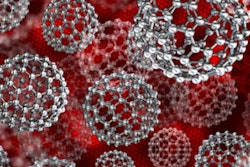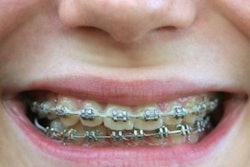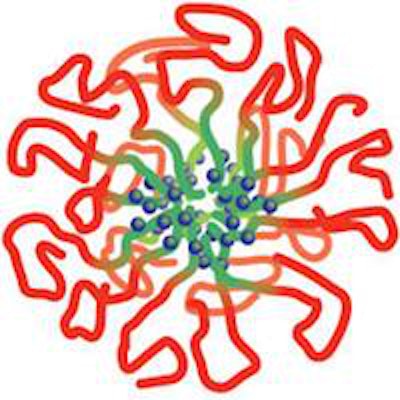
Researchers have created a way for nanoparticles to deliver an antibacterial agent directly to dental plaque, according to a new study. Their discovery could lead to better treatments for caries and other biofilm-related diseases.
Nanoparticles that deliver farnesol directly to cariogenic biofilm were created by researchers from multiple U.S. institutions. Farnesol is a naturally occurring antimicrobial agent that is effective against some caries-causing bacteria.
"We had two specific challenges," stated senior study author Danielle Benoit, PhD, assistant professor of biomedical engineering at the University of Rochester, in a press release. "We had to figure out how to deliver the antibacterial agent to the teeth and keep it there, and also how to release the agent into the targeted sites."
Nanoparticles stick to enamel and release farnesol
 Danielle Benoit, PhD, assistant professor of biomedical engineering, University of Rochester. All images courtesy of the University of Rochester.
Danielle Benoit, PhD, assistant professor of biomedical engineering, University of Rochester. All images courtesy of the University of Rochester.The researchers' method of delivering farnesol involves a multilayer nanoparticle carrier that sticks to enamel and releases the drug when pH levels drop (ACS Nano, March 2015, Vol. 9:3, pp. 2390-2404).
The carrier's positively charged outer layer adheres to the negatively charged hydroxyapatite of enamel, which prevents saliva from washing it away. The outer layer also bonds with the polymeric structure of caries-causing biofilm, allowing the particles to directly target plaque.
The inner layer of the drug delivery system is made up of hydrophobic and pH-sensitive material. Consequently, the nanoparticles quickly release farnesol when the plaque's pH levels drop after exposure to glucose, sucrose, starch, or other caries-causing foods.
Benoit and colleagues tested their nanoparticle carrier on rats that were infected with the caries-causing bacteria Streptococcus mutans. They applied the test solution to the rats' mouths twice daily for 30 seconds, simulating a person's potential morning and evening mouthwash use.
"When the drug [farnesol] was administered without the nanoparticle carriers, there was no effect on the number of cavities and only a very small reduction in their severity," stated co-senior study author Hyun Koo, DDS, PhD, professor at the University of Pennsylvania School of Dental Medicine. "But when it was delivered by the nanoparticle carriers, both the number and severity of the cavities were reduced."
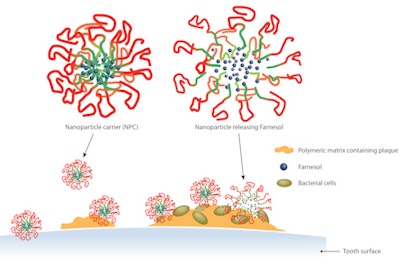
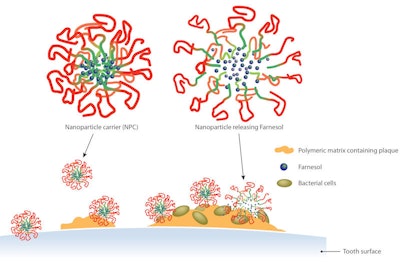
Farnesol is released from the nanoparticle carriers into the cavity-causing dental plaque. Graphic by Michael Osadciw, University of Rochester.
Interestingly, the researchers didn't set out at first to find a drug delivery system. In the process of their initial experiments, they found that the nanoparticles "bonded like crazy" to the dental biofilm, which they thought they could take advantage of.
"We turned those lemons and made them into lemonade," Benoit told DrBicuspid.com. "Often science is this way. You do a quick and dirty experiment expecting one outcome and observe something totally wonky and different than what you were expecting."
Next nanoparticle carrier research
The researchers are already continuing their work with the nanoparticle carriers. They are currently developing two-drug carriers that deliver farnesol and another drug with synergistic activity. They are also working to change the composition and features of the nanoparticle to further improve the release rate.
In addition, Benoit and colleagues are making strides toward testing the product in humans through clinical trials, but some hurdles, such as funding, are slowing them down.
"We have plans -- but just plans right now -- to start to translate this into patients," she said. "It takes a lot of data to make that happen."
The researchers have high hopes for the ultimate use of their product. Benoit imagines that once a dentist writes a prescription for a product with the nanoparticle carriers, people could make biofilm prevention a part of their daily oral health routine, like brushing and flossing.
"This could be introduced into your mouthwash, so you could swish with this morning and night," she said. "You could imagine putting this into your toothpaste, too ... or [on a product] akin to tooth-whitening strips."




